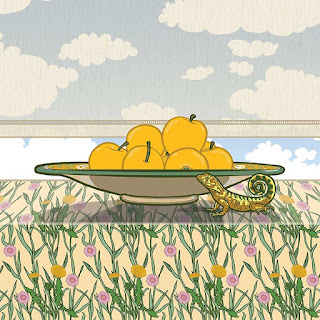In "Carnelian", la cui traduzione è Corniola, viene rappresentato il minerale in primo piano con incisa la runa Thurisaz, la cui capacità è di difenderci e proteggerci, ci invita alla calma e alla riflessione. La Corniola è indicata come sesta pietra di fondazione delle mura della Città Santa nell’apocalisse di Giovanni e indica l’apostolo Tommaso. Accanto alla pietra vi sono rappresentati alcuni attributi dell’apostolo, la squadra, il libro e la lancia. La pietra poggia sopra un tappeto Palas, del Tajikestan del XIX secolo. Il tappeto è un omaggio al divino e per sua natura crea un’atmosfera mistica, ad ogni nodo intrecciato è legato il pensiero di chi lo ha lavorato dedicandovi ore della propria vita. Su di un tappeto persiano è stato scritto: “Hanno filato la sua trama col filo dell’anima”. Questo lavoro appartiene alla serie intitolata "Way back into Soul", in cui sono rappresentati antichi miti in chiave moderna.
In “Carnelian", the mineral is represented in the foreground engraved with the Thurisaz rune, it has the ability to defend and protect us, it invites us to calm and reflect. Carnelian is indicated as the sixth foundation stone of the walls of the Holy City in the apocalypse of John and indicates the apostle Thomas. Next to the stone there are represented some attributes of the apostle, the square, the book and the spear. The stone rests on a Palas carpet from 19th century Tajikistan. The carpet is a tribute to the divine and by its nature creates a mystical atmosphere, the thoughts of those who worked on it are linked to each intertwined knot, dedicating hours of their lives to it. On a Persian carpet it was written: "They spun its weft with the thread of the soul". This work belongs to a series entitled "Way back into Soul", in which ancient myths are represented in a modern way.



